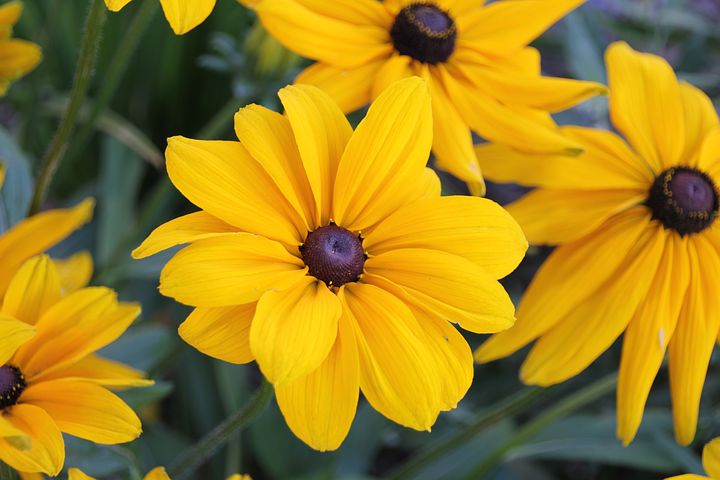No matter where you live, May is a busy time in the garden. No matter what your gardening interest/obsession—vegetables, flowers, roses, shrubs, and trees—it’s time to don your work gloves and dig in.

1. Decorate with Hanging Baskets
Brighten porches, patios, and pergolas with a generous helping of flowering hanging baskets. Filled to the brim with geranium, bidens, verbena, calibrachoa, petunia, annual phlox, or other flowers, hanging baskets require minimal care to keep them looking great all summer. Water them every day and offer them a dilute solution of liquid fertilizer every 10 days to keep them at their finest.
Tip: Remove faded flowers to encourage the development of new blooms. Your baskets will look tidier if you clip off dead flowers.
Get design ideas for your hanging baskets!
Download our free container gardening idea book for tips on hanging baskets.

2. Plant Tomatoes
Across most of the country, May is the ideal time to set out tomato plants. These heat-loving vegetables grow best when the nightly temperatures remain above 50 degrees F and all frost danger has passed.
Tip: If you’ve had problems growing tomatoes in the past, look for disease-resistant varieties. Look for the letters VFNT on the plant tags. This means that variety is resistant to verticillium, fusarium, nematodes, and tobacco mosaic virus – common diseases.
3. Go Tropical
Put away your passport! Plant a paradise in your own backyard with tropical beauties such as Tropic Escape hibiscus and mandevilla. These easy-care tropicals, along with other jungle favorites such as variegated ginger, canna, bird-of-paradise, palm, and ti plant, thrive as far north as Canada and Minnesota during the summer months. Move the plants indoors when frost threatens.
Tip: For best effect, plant hibiscus in a large pot and let annuals such as verbena or calibrachoa trail over the pot’s edge.
 4. Spice Up Your Garden
4. Spice Up Your Garden
Frost-sensitive herbs such as basil, dill, rosemary, marjoram, cilantro, and fennel can be planted now. These herbs require a sunny spot that receives at least 6 to 8 hours of sunlight a day. They need well-drained soil that doesn’t stay muddy after a rain. Or, you can plant them in containers right outside your kitchen door and snip fresh herbs whenever you need them.
Tip: The best time to harvest herbs is in the morning when the moisture and oils in the leaves are the most concentrated. Harvest right after the dew dries.
5. Bring On the Bulbs
In the northern part of the US, most spring-flowering bulbs, such as tulips, daffodils, and hyacinths have finished flowering. Clip away the dead flower stalks, but leave the foliage in place until it dries naturally. This allows the plant to build up strength for next year’s blooms. Meanwhile, it’s a great time to plant summer-flowering bulbs such dahlia, gladiolus, canna, tuberous begonia, calla, and caladium. Plant them in beds, borders, or containers. In frost-free areas, these bulbs will bloom all summer and can remain in the garden all year round.
Tip: Tall dahlia varieties require a stake or support to keep them from toppling in the wind. Install supports when you plant the bulbs so you can train the plants as they grow.
 6. Light Up the Shade
6. Light Up the Shade
Add a much-needed dose of color to shady spots in your landscape with versatile perennials such as hosta and heuchera (often called coral bells). Both of these super-easy perennials come in a wide variety of colors, sizes, and shapes. Hostas, for example, are available in 4-foot-tall giants as well as 4-inch-tall dwarfs. Plus, both hosta and heuchera are prized for their colorful foliage as well as their stalks topped with pretty flowers.
Tip: Tough enough to grow in almost any soil, hosta and heuchera will do better in a rich, organic mix. Mulch them to preserve soil moisture and eliminate weed competition.
See more easy perennials for shade!
7. Camouflage an Eyesore
Fast-growing and beautiful vines quickly scramble up and over unsightly buildings, garages, or fences. Annual vines such as morning glory, hyacinth bean, and cypress vine can be started from seed sown directly in the garden. Just sow the seeds about 6 inches away from the structure you want to cover. Perennial vines such as wisteria, honeysuckle, clematis, and trumpet vine offer a more permanent solution, but require sturdy supports to keep them upright. Tropicals such as mandevilla, jasmine, and sky vine are a spectacular option for frost-free climates.
Tip: Some perennial vines such as wisteria and trumpet vine can be vigorous and require regular pruning to keep them in check. Avoid planting them against your house where they might grow out of control.
8. Prune Shrubs
Early-flowering shrubs such as pussy willow, forsythia, azalea, and lilac can be pruned now (right after they finish blooming) if you want to shape them. If you wait more than three or four weeks after the shrubs flower, you’ll be removing developing flower buds for next year. Always use pruning shears, never use a hedge trimmer, and clip the branches off at different lengths inside the shrub for a more natural look. Avoid giving your landscape a severe crew cut.
Tip: If you have an old, severely overgrown shrub such as a lilac, cut the limbs back to the ground to rejuvenate the plant. You won’t get flowers for a few years, but the plant will sprout fresh growth from the base. Sprinkle a little granular fertilizer around the plant after pruning.
 9. Mulch, Mulch, Mulch — and Mulch Some More!
9. Mulch, Mulch, Mulch — and Mulch Some More!
The best way to keep your garden (and your back) healthy is to mulch your garden with several inches of compost, pine needles, shredded bark, grass clippings, straw, or even newspaper. The mulch helps preserve soil moisture during the hot months and prevents weeds from taking over. Weeds that do germinate will be easier to pull. As the mulch decays it adds organic matter to your soil.
Tip: Some mulches last longer than others. Shredded bark and pine straw, for example, only need to be replaced every few years and are ideal for established landscapes. For vegetable and flower beds use mulch that decays faster such as grass clippings or straw. That way you can add new plants each spring without digging through mulch.
See our guide to mulch.
 10. Bring On Butterflies
10. Bring On Butterflies
Attract colorful butterflies to your backyard by planting a banquet of flowers they love. For example, nectar-rich perennials such as coneflower, black-eyed Susan, salvia, phlox, butterfly bush,and dianthus will attract butterflies. To lure the most butterflies to your landscape, include plants the caterpillars can feed on. Parsley, carrot, dill, and fennel, for example, are a favorite food for the larvae of Black Swallowtail butterflies. Their black-and-yellow striped caterpillars devour the leaves of these plants so be sure to plant extra in your garden.
Tip: Annual flowers will also attract butterflies. Zinnia, cosmos, tithonia, pentas, and lantana are all nectar factories that butterflies will flock to. Grow some in containers and enjoy butterflies around your deck and patio.

